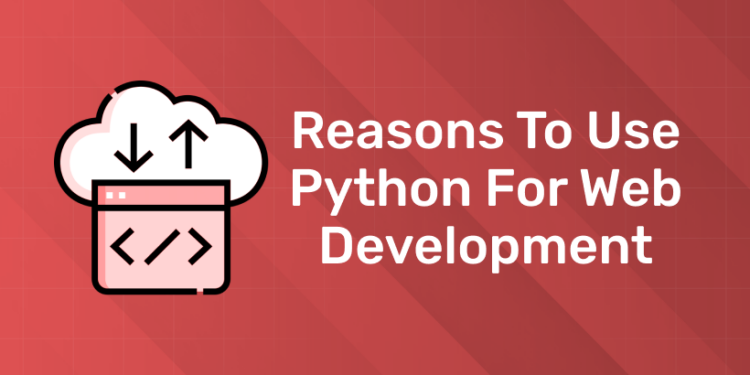Table of Contents
Web development can be difficult, with so many coding languages to pick from. Python stands out for its simplicity and adaptability. In this article we will discuss reasons to use python for web development.
In this blog post, we’ll explore Python’s features and its role in web development. We’ll also highlight the benefits of using Python and introduce you to a popular web development framework: Django.
Get hands-on with our python course – sign up for a free demo!
What is Python?
Python is a programming language created by Guido van Rossum in 1991. It’s known for being easy to read and write. People use Python for lots of things like making websites, analyzing data, and building artificial intelligence.
Python’s Key Features
Simple Syntax
- Python’s syntax is easy to understand and resembles plain English, making it accessible for beginners.
- Its readability reduces the learning curve and facilitates code comprehension and maintenance.
High-Level Language
- Python automates low-level tasks like memory management, enabling developers to focus on solving problems efficiently.
Interpreted Nature
- Python code is executed line by line by an interpreter, eliminating the need for compilation and speeding up development cycles.
- This allows for quick prototyping and easy debugging.
Dynamic Typing
- Python dynamically determines variable types at runtime, offering flexibility and reducing code verbosity.
- Developers don’t need to declare variable types explicitly, enhancing productivity.
Rich Standard Library
- Python provides a vast collection of modules and libraries for diverse tasks, from file handling to web development.
- These built-in tools streamline development and minimize the need for external dependencies.
Platform Independence
- Python code runs on various platforms without modifications, ensuring cross-platform compatibility.
- Developers can write code once and deploy it across different operating systems seamlessly.
Object-Oriented Support
- Python supports object-oriented programming (OOP) principles, allowing for modular and reusable code through classes and objects.
Thriving Community
- Python boasts a large and active community of developers who contribute to its ecosystem.
- This community provides support, resources, and a wealth of third-party libraries and frameworks.
Scalability and Versatility
- Python can be used for projects of any scale, ranging from small scripts to large-scale applications.
- Its versatility spans multiple domains, including web development, data science, machine learning, and automation.
Open-Source Nature
- Python is open-source and free to use, encouraging collaboration and innovation.
- Developers can access, modify, and distribute Python’s source code, fostering continuous improvement and evolution.
Why Python?
Python’s Beginnings and Style
- Python was created by Guido van Rossum in 1991.
- It focuses on easy-to-read code with simple syntax and indentation rules.
Easy to Use Everywhere
- Works on Windows, Linux, and Mac.
- Can be used in different coding styles and industries like AI, Healthcare, and Finance.
Trusted by Big Companies
- Google, Microsoft, and others use Python in their services.
- Its popularity with these companies shows its reliability and usefulness.
Top reasons to use Python for Web Development
1: Which of the following data types is immutable in Python?
Easy to Use and Read
- Python has a low entry barrier, making it accessible for new programmers to learn and join the coding community quickly.
- The language’s simplicity and clear syntax enable better understanding and organization of intricate systems.
- Python offers good visualization capabilities, allowing developers to represent data effectively using libraries like Matplotlib.
Asynchronous Coding
- Python excels in managing asynchronous code, ensuring smooth execution and problem-solving.
- Its ability to handle diverse situations independently speeds up the development process.
- Python’s proficiency in managing asynchronous tasks makes it ideal for companies aiming to expedite product creation.
Less-Limited Programming Approach
- Python supports multiple programming paradigms, including procedural, object-oriented, and functional, offering developers more flexibility.
- Compared to languages like Java, Python has a less-restricted approach, allowing for easier adaptation to changing project requirements.
- Its versatility makes Python suitable for startups and projects where programming needs may evolve rapidly.
Frameworks for Web Development
- Python offers several frameworks like Django, Pyramid, and Flask, which simplify the web development process.
- Django is suitable for large-scale web applications with built-in features and support for various databases.
- Pyramid is flexible and scalable, allowing developers to start small and extend functionality as needed.
- Flask provides a simple and customizable solution, ideal for small-scale projects and prototyping.
Applications in Scientific and Numeric Fields
- Python offers numerous libraries and toolkits for developing scientific and numeric applications, such as SciPy and Pandas.
- It is widely used in machine learning and artificial intelligence projects due to its efficient ML packages and extensive toolset.
- Python’s simplicity and readability make it suitable for application scripting, software testing, and test automation.
Prototyping and Open-Source Perks
- Python facilitates rapid prototyping and code refactoring, enabling quick development from prototype to final product.
- Its open-source license encourages collaboration and contribution from developers, leading to continuous improvement.
- Python’s simplicity and portability make it suitable for server-side scripting and interactivity, enhancing web development efficiency.
Scalable and Adaptable
- Python’s adaptability and abundance of libraries enable rapid scaling of projects and easy adjustment of approaches.
- Its flexibility allows developers to change direction quickly, which is beneficial for startups where time is crucial for securing venture capital.
Web Scraping
- Python is commonly used for web scraping to collect data from websites due to its simplicity and ability to handle large datasets.
- Developers leverage Python libraries to automate data extraction tasks, saving time and effort in writing code.
Integration with Other Languages
- Python seamlessly integrates with languages like Ruby, C, Java, and PHP, facilitating the connection and extension of existing structures.
- This capability is essential for building web applications that require interoperability with different technologies and platforms.
Using Python for Web Development: A Beginner’s Guide
Install Python and Choose a Web Framework:
- Download Python from the official website.
- Install a web framework like Django, Flask, Pyramid, or Bottle using commands like “pip install Django.”
Set Up the Environment and Start a New Project:
- Create a project folder and activate the chosen framework.
- For Django, use the command “django-admin startproject projectname.”
Configure Your Settings:
- Customize project settings like database configurations and security options.
- Seek professional help if needed.
Specify the Logic of Your Website:
- Use Views to design response forms and Templates to structure web pages.
- Ensure engagement with interactive features and tools.
Define URL Routes:
- Confirm or adjust URL routes provided by the framework for proper navigation.
Connect Databases:
- Link SQL or NoSQL databases to store and manage data effectively.
Customize the Sales Funnel:
- Focus on income-generating features like payment options.
Test and Deploy:
- Thoroughly test the website for bugs before deploying it on a server.
- Ensure everything functions correctly before making it publicly accessible.
Limitations of Python for Web Development:
Despite its advantages, Python has some drawbacks to consider for web development.
Fewer Experienced Developers
- Python lacks as many experienced developers as other languages like Java, which may make finding skilled professionals more challenging.
Limited Multiprocessor Support
- While Python does support multiprocessing, it may not be as flexible as other languages, leading to limitations in coding.
Speed Issues
- Python’s interpreted nature can make it slower compared to languages like C/C++ or Java, though some benchmarks show competitive performance.
Not Popular for Mobile Development
- Python isn’t commonly used for mobile app development, so finding experienced Python mobile developers may be difficult.
Not Suitable for Memory-Intensive Tasks
- Python’s flexibility with data types can result in higher memory usage, making it less ideal for memory-intensive tasks.
Design Constraints
- Python’s dynamic typing and limited support for concurrency and parallelism may impose design restrictions on projects, affecting their sophistication and performance.
Get hands-on with our python course – sign up for a free demo!
What is Python Django ?
Understanding Django
- Django is a Python framework for building complex and scalable websites, contributing to Python’s recent rise in popularity.
- It follows the model-view-template (MVT) architecture, which organizes code based on best practices.
Components of Django
- Model: Represents database tables and simplifies tasks like creating, deleting, or updating table entries.
- View: Defines the user interface, rendering templates with HTML, CSS, and JavaScript files.
- Template: A static HTML structure file with special syntax that describes the inserted content.
Django Features
Organized Architecture
- Django follows the Model-View-Template (MVT) pattern, simplifying code organization into models, views, and templates.
Database Interaction
- Django’s ORM abstracts SQL queries into Python code, making database interaction easier and more portable.
Admin Interface
- Built-in admin interface for effortless management of website content and user authentication.
URL Routing
- Clear and organized URL patterns mapping to views for handling different application functionalities.
Template Engine
- Dynamic HTML template creation using template tags and filters for separating logic and presentation.
Form Handling
- Simplified form handling with form classes for validation, rendering, and processing of HTML forms.
Authentication and Authorization
- Robust systems for user registration, login, and access control with minimal setup.
Security Features
- Built-in security measures like CSRF protection, XSS prevention, and password hashing for enhanced security.
Scalability
- Architecture designed for scalability, enabling efficient handling of large traffic and data volumes.
Admin Interface
- Powerful interface for managing site content, users, and permissions without additional coding.
Community Support
- Active developer community contributing plugins, libraries, and resources for continuous improvement.
Comprehensive Documentation
- Well-maintained documentation with tutorials, guides, and references for effective learning and troubleshooting.
Usage and Examples
- Many popular websites like Spotify, Instagram, and YouTube were built using Django, showcasing its effectiveness and reliability in real-world applications.
Entri’s Python Course for Web Development
Entri’s python course for web development covers the following topics:
- Python Basics: Learn the fundamentals of Python programming.
- Object-Oriented Programming (OOP): Master OOP concepts and apply them in Python.
- Advanced Python: Explore advanced Python topics and libraries for efficient coding.
- Introduction to Django: Get started with Django for web development in Python.
- Views and URL Configuration: Create views and manage URLs in Django applications.
- Forms and User Input: Handle user input using forms in Django.
- Django Templates and Static Files: Design dynamic interfaces and manage static files.
- Middleware and Context Processors: Implement middleware and context processors in Django.
- Django Testing: Write tests to ensure application reliability.
Conclusion:
Python is a great coding language known for its simplicity and power. It’s been around for a while and is used to create many popular websites.
When it comes to building web applications, you have two main options: Django and Flask. While both have their strengths, Django is often preferred by less experienced developers because it’s easier and faster to use.
Ready to take your python skills to the next level? Sign up for a free demo today!
Related Articles
Frequently Asked Questions
What are the main reasons to choose Python for web development?
Python offers simplicity, readability, and versatility, making it ideal for web development projects. Its extensive ecosystem of frameworks, libraries, and tools streamlines the development process, allowing developers to build robust and scalable web applications efficiently.
Is Python used for the front end?
While Python is primarily used for back-end development, it can also be used for front-end tasks with frameworks like Django, which include templating engines to generate HTML content. However, JavaScript is more commonly used for front-end development due to its widespread support in web browsers.
Which popular companies use Python in their websites?
Several popular companies use Python in their websites and web applications. Some notable examples include:
-
- Instagram: A social media platform owned by Facebook.
- YouTube: A video-sharing website owned by Google.
- Spotify: A digital music streaming service.
- Dropbox: A cloud storage service.
- Reddit: A social news aggregation platform.
- Pinterest: A visual discovery and bookmarking tool.
- Quora: A question-and-answer website.











